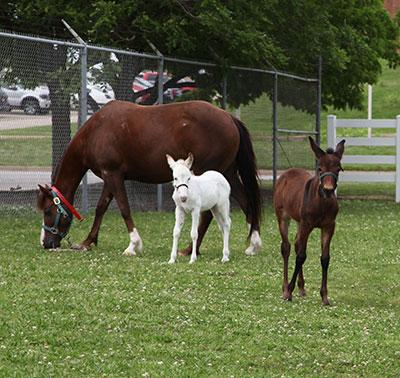
Twice the Challenge
Sunday, April 30, 2017
Shirley Rosenbaum runs Meadowcreek Equine Rescue Mission in Fox, Ark. She acquired a mare she calls Sarah in July 2016. The horse was not in good physical condition. A veterinarian told Rosenbaum that the horse had a broken pelvis. With care, Sarah was able to get up on her own within a month. Several months later, Rosenbaum discovered the horse was pregnant.
“One veterinarian told me it would kill her,” said Rosenbaum. “Another said she had a 50/50 chance and a third veterinarian said maybe she will be all right. Dr. Bill Nixon in Mountain View, Ark., told me the only thing to do was take her to OSU because she may have to have a caesarian. So I drove her to OSU’s Center for Veterinary Health Sciences Ranch.”
Upon her arrival at the Ranch, Sarah was put on a 24/7 foal watch to monitor labor and birth of the expected foal. Rosenbaum speculated that Sarah was impregnated by a donkey that was located next to Sarah’s former home. Sure enough on March 20, 2017, OSU veterinarians called to say Sarah had given birth to not one but twin mules—one white and one brown. Twins that survive are very rare in the equine business.
Shortly after birth, mother and twins were transported to OSU’s Veterinary Medical Hospital. Veterinarians determined that the white mule didn’t have adequate passive transfer and needed plasma. She was also showing signs of sepsis, which required antibiotics and fluids.
“We sat beside these foals 24/7 literally around the clock until they were stable,” reported Dr. Lyndi Gilliam, board certified equine internal medicine specialist. “The white filly was found to have underdeveloped bones. This is not uncommon in twins where one baby gets more nutrition. This can be a life threatening condition. At one point splints were applied to her left front limb. Many therapies were instituted to ensure her bones developed without being crushed including a special cart for her to walk without putting too much pressure on her bones. She also spent exercise time in our underwater treadmill.”
A little over a month later, the twins and mare are ready to go home.
“Everyone was so dedicated and so good and careful,” said Rosenbaum. “They kept them alive. They stayed with them and watched them. They called every day and told me how they were doing. Oklahoma and Oklahoma State are so fortunate to have this group of wonderful veterinarians and students who care so much about their job. This is not a $50,000 horse. She’s just a horse of some breed but that didn’t matter to these doctors. I will be forever grateful. I hope that the whole state appreciates their expertise and their dedication. They are a fine group of people and I am honored to be associated with any of them.”
For more information on OSU’s Center for Veterinary Health Sciences visit the CVHS website.
